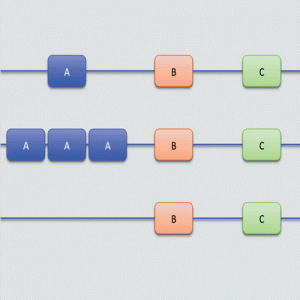Copy Number Variation
 For years, single nucleotide polymorphisms (SNPs) were thought to be responsible for the majority of human variation. Until recently, larger-scale changes (1,000+ nucleotides in length), known as copy number variants (CNV), were thought to be relatively rare. However, scientists have discovered that CNVs occur much more frequently than was suspected. These structural changes alter the number of copies of a specific DNA segment.
For years, single nucleotide polymorphisms (SNPs) were thought to be responsible for the majority of human variation. Until recently, larger-scale changes (1,000+ nucleotides in length), known as copy number variants (CNV), were thought to be relatively rare. However, scientists have discovered that CNVs occur much more frequently than was suspected. These structural changes alter the number of copies of a specific DNA segment.
It came as a surprise to many scientists just how much DNA variation is due to copy number changes. Previous studies based primarily on SNPs suggest- ed that any two randomly selected human genomes would differ by 0.1%. CNVs revise that estimate: the two genomes differ by at least 1.0%. While this may not seem like a major increase, remember that the human genome is composed of approximately three billion nucleotides, so the estimated number of nucleotides that vary between two random individuals has increased from three million to 30 million. Humans are still nearly 99% identical at the DNA sequence level, but the CNV research has broadened our understanding of how and where we differ.
It has been suggested that CNV regions influence gene activity by directly increasing or decreasing the number of copies of that gene, leading to a concurrent change in the amount of protein. Alternately, CNVs may alter the performance of nearby regulatory signals that activate or silence genes without directly impacting the copy number of the gene itself.
Preliminary studies have linked CNVs to lupus, Crohn’s disease, autism spectrum disorders, Alzheimer disease, HIV-1/AIDS susceptibility, rheuma- toid arthritis and Parkinson disease. In some cases the associated CNV is rare, but in other diseases, the identified risk variant is quite common. It is also likely that CNVs may influence individual drug response and susceptibility to infection or cancer.


